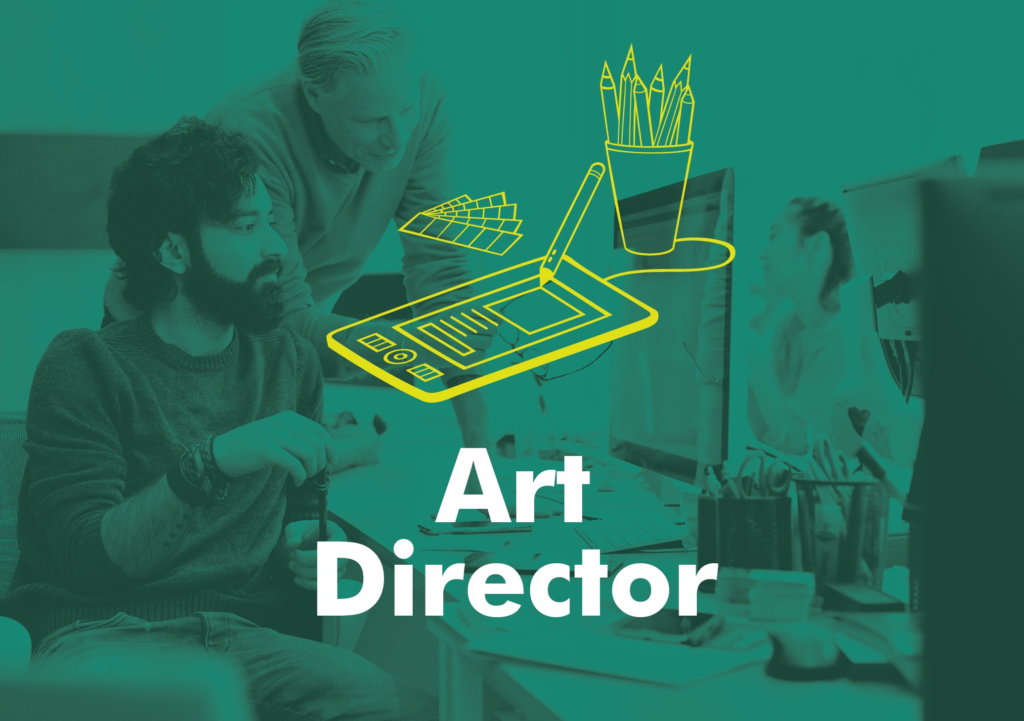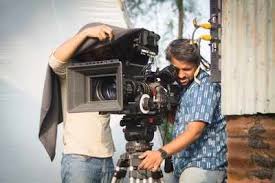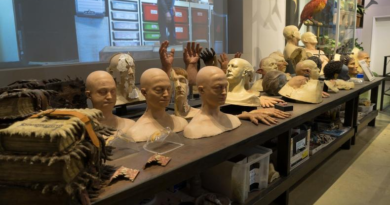Art Director (1 years diploma)
Art Director click here
Brief Job Description: Individuals in this job need to determine the visual
appearance of the set. The art director designs all the key elements of the set
and co-ordinates the construction/ execution of this creative vision.
Personal Attributes: This job requires the individual to interpret the script and
developing visual concepts for sets. The individual must have a background in
the fine arts and a creative bent of mind. The individual must also know how to
use design tools and concepts to visualize the set, including the time period and
location where the film is based. The individual must have knowledge of

construction techniques and how to supervise the construction team. The
individual must have strong communication skills and must possess the ability to
guide efforts and work collaboratively. The individual must be flexible and able
to make key decisions, keeping in mind the impact on cost and timelines.
Description
Blueprint A technical drawing of an architecture or engineering design, typically
with measurements and angles of each component
Budget Budget is an estimate of the total cost of production that may include a
break-up of cost components
Construction Schedule A detailed breakdown of activities for a construction project, with the
duration of each activity and organized in sequential order
Continuity Continuity represents the seemless transition from one shot to another
Copyright Laws A legal framework linked to intellectual property and the rights given to
creators of original products/ concepts
Draftsman (1) A visual artist who specialises in artistic drawings. Or, (2) A person
who prepares technical drawings and plans under the direction of an
architect or engineer or designer.
Dress Set Decorating the set for aesthetic/ visual purposes
Labour Laws Legal norms governing the relationship between workers, employers,
trade unions and the government
Post-production Post-production is the final finishing phase of the production, where the
raw footage is edited, special effects are added, music and sound are
integrated, colour correction is done etc.

Props A property, commonly shortened to prop (plural: props), is an object
used on stage or on screen by actors during a performance or screen
production. In practical terms, a prop is considered to be anything
movable or portable on a stage or a set.
Scale Drawings A drawing that depicts the accurate dimensions of an object, except they
have all been reduced or enlarged by a certain fixed percentage (called
the scale).
Screenplay Screenplay is the script coupled with key characteristics of the scene and
directions for acting
Script Script is a structured narrative of a story
Set The background/ scenery visible through the camera (for video
production) or directly to the spectator (for theatrical production)
Set Etiquette A set of guidelines that dictate how cast and crew should behave on set
and interact with each other Strike Set Process of dismantling the set (including moveable items and
semipermanent fixtures), and storing, discarding or returning these items
Timelines Timelines is a listing of dates by which the production milestones/stages
need to be completed
Sector Sector is a conglomeration of different business operations having similar
businesses and interests. It may also be defined as a distinct subset of the
economy whose components share similar characteristics and interests.
Sub-sector Sub-sector is derived from a further breakdown based on the
characteristics and interests of its components.
Vertical Vertical may exist within a sub-sector representing different domain
areas or the client industries served by the industry
Occupation Occupation is a set of job roles, which perform similar/related set of
functions in an industry
Function Function is an activity necessary for achieving the key purpose of the
sector, occupation, or area of work, which can be carried out by a person
or a group of persons. Functions are identified through functional
analysis and form the basis of OS.
Sub-functions Sub-functions are sub-activities essential to fulfill the achieving the
objectives of the function.
Job role Job role defines a unique set of functions that together form a unique
employment opportunity in an organization.
Occupational Standards

(OS)
OS specify the standards of performance an individual must achieve
when carrying out a function in the workplace, together with the
knowledge and understanding they need to meet that standard
consistently. Occupational Standards are applicable both in the Indian
and global contexts.
Performance Criteria Performance Criteria are statements that together specify the standard
of performance required when carrying out a task
National Occupational
Standards (NOS)
NOS are Occupational Standards which apply uniquely in the Indian
context.
Qualifications Pack
Code
Qualifications Pack Code is a unique reference code that identifies a
qualifications pack.
Qualifications Pack(QP) Qualifications Pack comprises the set of OS, together with the
educational, training and other criteria required to perform a job role. A
Qualifications Pack is assigned a unique qualification pack code.
Unit Code Unit Code is a unique identifier for an Occupational Standard , which
isdenoted by an ‘N’.
Unit Title Unit Title gives a clear overall statement about what the incumbent
should be able to do.
Description Description gives a short summary of the unit content. This would be
helpful to anyone searching on a database to verify that this is the
appropriate OS they are looking for.
Scope Scope is the set of statements specifying the range of variables that an
individual may have to deal with in carrying out the function which have
a critical impact on the quality of performance required.
Knowledge and
Understanding
Knowledge and Understanding are statements which together specify the
technical, generic, professional and organizational specific knowledge
that an individual needs in order to perform to the required standard.
Organizational Context Organizational Context includes the way the organization is structured
and how it operates, including the extent of operative knowledge
managers have of their relevant areas of responsibility.
Technical Knowledge Technical Knowledge is the specific knowledge needed to accomplish
specific designated responsibilities.
Core Skills/Generic
Skills
Core Skills or Generic Skills are a group of skills that are key to learning
and working in today’s world. These skills are typically needed in any
work environment. In the context of the OS , these include
communication related skills that are applicable to most job roles.
Keywords /Terms Description
CAD Computer Aided Design
NOS National Occupational Standard(s)
QP Qualifications Pack
NVEQF National Vocational Education Qualifications Framework
NVQF National Vocational Qualifications Framework
Develop Set Design
Description This OS unit is about interpreting the script, developing visual concepts for sets and
agreeing on them with the key creative team

Scope This unit/task covers the following:
Developing designs/ visual representations for sets
Performance Criteria (PC) w.r.t. the Scope
Element Performance Criteria
Developing designs/
visual representations
for sets
To be competent, the user/individual on the job must be able to:
PC1. Correctly interpret the script and creative brief, and visualize the sets that
need to be created
PC2. Carry out research and provide visual references to support specific
visualizations of set construction, which may include:
Hand drawings
Graphic designs
Computer aided designs (CAD)
Physical models
PC3. Understand measurements and space requirements, and use this effectively
to develop set visualizations (both to scale and otherwise)
PC4. Effectively communicate designs to key members of the creative team
(Production Designer, Director, Producers) and agree upon a final design
Knowledge and Understanding (K)
A. Organizational
Context (Knowledge
of the company /
organization and
its processes)
The user/individual on the job needs to know and understand:
KA1. The creative vision of the Director and Producer
KA2. Key expectations from the shoot, specifics of the location and any key
limitations on budget, resources and time availability
B. Technical
Knowledge
The user/individual on the job needs to know and understand:
KB1. How to interpret the script and creative brief and create a set requirement
KB2. The use of design tools and concepts to visualize each set (this could include
the time period and location where the film is based e.g. 1950s in an Indian
village, the overall mood of the film and key scenes to be shot at that set)
KB3. How to conduct research and identify appropriate visual references (either of
one’s own work or material available in the public domain)
KB4. The use of hand drawing and computer design techniques to create set
visualizations/ concepts
KB5. How to present one’s ideas/ concepts to the creative team (Production
Designer, Director and Producer)
KB6. The implications of each set visualization/ concept on key aspects of
production e.g. time, materials, location and budget
KB7. Appropriate modifications/ alternatives to set concepts based on any
constraints/ limitations

KB8. Available post production techniques that can be used to enhance the set and
reinforce the mood of filming, and the corresponding impact on the set
construction schedule and budget
KB9. Applicable health and safety guidelines, and ensuring that the selected set
designs minimize any risks to the individual’s own health and safety as well as
those of the production cast and crew
Develop Set Design
Skills (S)
A. Core Skills/
Generic Skills
Writing Skills
The user/ individual on the job needs to know and understand how to:
SA1. Prepare set and items lists based on the requirements of the script
SA2. Use hand drawing and computer design techniques to create set visualizations
Reading Skills
The user/individual on the job needs to know and understand how to:
SA3. Interpret the script and creative brief
SA4. Read relevant research and identify visual references
Oral Communication (Listening and Speaking skills)
The user/individual on the job needs to know and understand how to:
SA5. Understand the creative vision of the Director and Producer
SA6. Understand any constraints/ limitations that affect the set design (e.g. time,
people, materials, location, budget)
SA7. Communicate effectively with the Production Designer, Director and
Producer and propose alternatives and agree on key decisions
B. Professional Skills Decision Making
The user/individual on the job needs to know and understand how to:
SB1. Make relevant decisions related to the area of work e.g. choice of visual
references, set construction techniques etc.
Plan and Organize
The user/individual on the job needs to know and understand:
SB2. Plan his/her work according to the requirements and agreed timelines
SB3. Manage within the agreed budget and minimize overruns
Problem Solving
The user/individual on the job needs to know and understand how to:
SB4. Identify any problems with successful execution of the task and resolve them
in consultation with the Production Designer (and where required, the
Director and Producer)
Analytical Thinking
The user/individual on the job needs to know and understand how to:
SB5. How to assess the impact of selecting different production techniques on the
time, location and budget of the set design
Critical Thinking
The user/individual on the job needs to know and understand how to:
SB6. Appraise the quality of the designs to ensure they are in line with the
expected quality standards and suggest areas of improvement.
Customer Centricity
The user/individual on the job needs to know and understand how to:
SB7. How to prepare a set design that meets all the artistic or communication aims
of the project
Prepare a Set Construction Plan
Description This OS about translating set visual concepts into scale drawings, detailed set
blueprints and a plan for executing construction of the set
Scope This unit/task covers the following:
Translating set designs/ visual representations
Performance Criteria (PC) w.r.t. the Scope
Element Performance Criteria
Translating set
designs/ visual
representations
To be competent, the user/individual on the job must be able to:
PC1. Correctly interpret the script, creative brief and set visualization – in order to
create a comprehensive set requirement
PC2. Take measurements on location and detail out different aspects of each set
through scale drawings, blueprints (by hand or CAD) or physical models
PC3. Research and understand construction techniques including painting,
carpentry and plasterwork to accurately specify requirements
PC4. Develop a construction schedule and budget for each set – detailing out the
time, material and resources require to complete the project
Knowledge and Understanding (K)
A. Organizational
Context
(Knowledge of the
company /
organization and
its processes)
The user/individual on the job needs to know and understand:
KA1. The creative vision of the Director and Producer
KA2. Key expectations from the shoot, specifics of the location and any key
limitations on budget, resources and time availability
B. Technical
Knowledge
The user/individual on the job needs to know and understand:
KB1. How to interpret the script and creative brief and create a set requirement
KB2. How to take measurements at the location where sets are expected to be
installed, and how to account for additional space required for filming,
workspaces and storage (for e.g. minimum height required to accommodate
mounted/ rigged cameras)
KB3. The use of hand drawing and computer design techniques to create detailed,
three-dimensional set drawings/ blueprints to scale. (The ability to supervise
a team of draftsmen who create scale drawings using CAD is also important)
KB4. Applicable construction techniques including painting, carpentry and
plasterwork that are required to build the set
KB5. The implications of each set design on key aspects of production e.g. time,
materials, location and budget
KB6. Techniques to reduce the cost of set construction, given that production
requirements are usually to create low cost/ artifical/ temporary construction
KB7. Available post production techniques that can be used to enhance the set and
reinforce the mood of filming, and the corresponding impact on the set
construction schedule and budget
KB8. How to break down CAD drawings/ blueprints into a list of activities in
sequence and translate them into a construction schedule
KB9. How to create a materials list (bill of quantities) and a construction budget,
based on information provided in CAD drawings/ blueprints
KB10. Applicable health and safety guidelines, and ensuring that the materials list
and construction schedule minimize any risks to the individual’s own health
and safety as well as those of the production cast and crew
Skills (S)
A. Core Skills/
Generic Skills
Writing Skills
The user/ individual on the job needs to know and understand how to:
SA1. Use hand drawing and computer design techniques to create set blueprints
SA2. Prepare construction schedules, material lists and budgets (either by hand or
using software like MS Excel, MS Project etc.)
Reading Skills
The user/individual on the job needs to know and understand how to:
SA3. Interpret the script, creative brief and set designs
SA4. Read and check construction schedules, material lists and budgets
Oral Communication (Listening and Speaking skills)
The user/individual on the job needs to know and understand how to:
SA5. Understand the creative vision of the Director and Producer
SA6. Understand any constraints/ limitations that affect the set design (e.g. time,
people, materials, location, budget)
SA7. Communicate effectively with the Production Designer, Director and
Producer and propose alternatives and agree on key decisions
B. Professional Skills Decision Making
The user/individual on the job needs to know and understand how to:
SB1. Make relevant decisions related to the area of work e.g. set construction
techniques, planning and sequencing of tasks etc.
Plan and Organize
The user/individual on the job needs to know and understand:
SB2. Plan the construction schedule in a cost-effective and time sensitive manner
SB3. Budgeting and planning techniques for construction, in order to ensure that
set construction in line with the agreed budget
Problem Solving
The user/individual on the job needs to know and understand how to:
SB4. Identify any problems with successful execution of the task and resolve them
in consultation with the Production Designer (and where required, the
Director and Producer)
Analytical Thinking
The user/individual on the job needs to know and understand how to:
SB5. How to assess the impact of selecting different production techniques, cast,
crew, vendors and suppliers on the time, location and budget of the set
Customer Centricity
The user/individual on the job needs to know and understand how to:
SB6. prepare a work schedule/ sequence that meets all the artistic or
communication aims of the project
Critical Thinking
The user/individual on the job needs to know and understand how to:
SB7. Appraise the quality of the production to ensure it is in line with the expected
quality standards and suggest areas of improvement, if required.
Commission and Supervise Set Construction
Description This OS about commissioning a team to construct the set, procuring required
materials and tools and monitoring the progress of construction
Scope This unit/task covers the following:
Commissioning a construction team and procuring materials and tools
Briefing the construction supervisors
Monitoring the progress of set construction
Performance Criteria (PC) w.r.t. the Scope
Element Performance Criteria
Commissioning a
construction team
and procuring
materials and tools
To be competent, the user/individual on the job must be able to:
PC1. Recruit the right construction team
PC2. Procure materials and tools, in a cost-effective and timely manner
Briefing the
construction
supervisors
PC3. Provide instructions and guidance on the key tasks to be carried out by the
set construction team, and ensuring items are transported safely and securely
to the location of the set
Monitoring the
progress of set
construction
PC4. Closely monitor the construction schedule and budget, to ensure that the
project is delivered on time and within the agreed budget
Knowledge and Understanding (K)
A. Organizational
Context
(Knowledge of the
company /
organization and
its processes)
The user/individual on the job needs to know and understand:
KA1. The creative vision of the Director and Producer
KA2. Key expectations from the shoot, specifics of the location and any key
limitations on budget, resources and time availability
KA3. Key processes related to procurement and budgetary approval e.g.
submission of bills for items procured to the Finance department
B. Technical Knowledge
The user/individual on the job needs to know and understand:
KB1. Applicable construction techniques including painting, carpentry and
plasterwork that are required to build the set
KB2. Techniques to reduce the cost of set construction, given that production
requirements are usually to create low cost/ fake/ temporary construction
KB3. Available construction crew in the market, their suitability for the project and
implications on the construction budget
KB4. How to recruit a construction team including supervisors and workmen,
negotiate salary/ wages and contract terms
KB5. Applicable union rules and labour laws that may apply to construction crews
KB6. Available material and tool suppliers, their suitability for the project and
implications on the construction budget
KB7. Techniques to procure materials and tools in a cost-effective manner
KB8. Appropriate modes of transport and storage to bring construction materials
and tools safely and securely to the location
KB9. How to communicate the design brief to construction supervisors
KB10. Techniques for tracking progress and ensuring that deadlines are being met
as laid out in the construction schedule
KB11. Available post production techniques that can be used to enhance the set and
reinforce the mood of filming, and the corresponding impact on the set
construction schedule and budget
KB12. Applicable health and safety guidelines, and ensuring that the set
construction schedule minimize any risks to the individual’s own health and
safety as well as those of the production cast and crew
Skills (S)
A. Core Skills/
Generic Skills
Writing Skills
The user/ individual on the job needs to know and understand how to:
SA1. Prepare construction schedules, material lists and budgets (either by hand or
using software like MS Excel, MS Project etc.)
SA2. Prepare progress updates and highlight any variance with respect to time or
budget (either using handwritten updates or using software like MS Word, MS
Excel, MS Project etc.)
Reading Skills
The user/individual on the job needs to know and understand how to:
SA3. Read and check recruitment-related documentation (CVs, past projects,
employment contracts, union guidelines/ norms)
SA4. Read and check construction schedules, material lists and budgets
Oral Communication (Listening and Speaking skills)
The user/individual on the job needs to know and understand how to:
SA5. Understand the creative vision of the Director and Producer
SA6. Understand any constraints/ limitations that affect the set design (e.g. time,
people, materials, location, budget)
SA7. Communicate effectively with the construction crew (supervisors of key crafts
like carpentry, painting etc.), propose alternatives and agree on key decisions
SA8. Communicate effectively with the Production Designer, Director and
Producer and propose alternatives and agree on key decisions (especially on
aspects related to construction delays and/ or budgetary overruns)
B. Professional Skills Decision Making
The user/individual on the job needs to know and understand how to:
SB1. Make relevant decisions related to the area of work e.g. set construction
techniques, planning and sequencing of tasks etc.
Plan and Organize
The user/individual on the job needs to know and understand:
SB2. Plan the construction schedule in a cost-effective and time sensitive manner
SB3. Track the budget and schedule – to ensure that set construction remains
within the agreed budget and is delivered on time
Problem Solving
The user/individual on the job needs to know and understand how to:
SB4. Identify any problems with successful execution of the task and resolve them
in consultation with the construction crew (and where required, the
Production Designer, Director and Producer)









